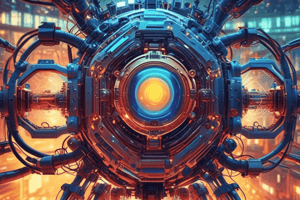Podcast
Questions and Answers
Makine öğrenimi nedir?
Makine öğrenimi nedir?
- Belirli bir programlama talimatı olmadan verileri analiz eder
- Makineleri daha etkili görevler yapabilecek şekilde yeteneğe sahip yapay zeka
- Bilgisayarların verilerden öğrenmesine olanak tanır (correct)
- Yapay zeka ile insan zekasını simüle eden cihazlar ve algoritmalar
Denetimli öğrenme yöntemi neyi sağlar?
Denetimli öğrenme yöntemi neyi sağlar?
- Etiketli giriş verilerine ihtiyaç duymaz
- Giriş özelliklerini istenilen çıktılara eşleştirmek için etiketli eğitim örnekleri sağlar (correct)
- Önceki kullanım trendlerini analiz etmez
- Makine öğreniminin bir türü değildir
Denetimsiz öğrenme neyi gerektirmez?
Denetimsiz öğrenme neyi gerektirmez?
- Etiketli giriş verileri (correct)
- Önceki kullanım trendleri
- Analiz edilecek veri
- Modelin giriş özelliklerini haritalamak için etiketi olan eğitim örnekleri
Makine öğreniminin amacı nedir?
Makine öğreniminin amacı nedir?
Hangisi denetimli öğrenme yöntemine örnektir?
Hangisi denetimli öğrenme yöntemine örnektir?
Hangisi denetimsiz öğrenme ile ilgili doğru bir ifade değildir?
Hangisi denetimsiz öğrenme ile ilgili doğru bir ifade değildir?
Yapay zeka uygulamalarının kapsamı hangi sektörleri içerebilir?
Yapay zeka uygulamalarının kapsamı hangi sektörleri içerebilir?
Nöral ağların oluşturulması sırasında hangi yapı kullanılır?
Nöral ağların oluşturulması sırasında hangi yapı kullanılır?
'Pekiştirmeli öğrenme' nedir?
'Pekiştirmeli öğrenme' nedir?
Nöral ağlarda hangi unsurlar sinyalleri aktarır?
Nöral ağlarda hangi unsurlar sinyalleri aktarır?
'Öneri sistemi', ne işe yarar?
'Öneri sistemi', ne işe yarar?
Nöral ağlarla ilgili yanlış bir inanış hangisidir?
Nöral ağlarla ilgili yanlış bir inanış hangisidir?
Study Notes
Artificial Intelligence: A Guide to Machine Learning, Neural Networks, and Beyond
Artificial Intelligence (AI) is transforming our world—from personal assistants on smartphones to self-driving cars. But what exactly is AI? In essence, it's simulating human intelligence through devices and algorithms to enable machines to perform tasks more efficiently. Here we delve into its core concepts, such as machine learning and neural networks, which have fueled this technological revolution.
What Is Machine Learning?
Machine learning allows computers to learn from data without explicit programming instructions. They analyze this data, discover patterns among them, and apply these findings to make decisions or predictions based on new information. For example, machine learning models can identify fraudulent credit card transactions by analyzing past usage trends.
Types of Machine Learning
There are three main types of machine learning algorithms: supervised learning, unsupervised learning, and reinforcement learning.
Supervised learning: This method provides labeled training examples so the model can map input features onto desired outputs. For instance, you might teach a model how to recognize different species of birds using images with known labels attached.
Unsupervised learning: Unlike supervised methods, unsupervised learning does not require labeled input data. Instead, the algorithm discovers structure within the data itself, clustering items together where their characteristics resemble each other. An example would be a recommendation system suggesting books similar to those already enjoyed by a user.
Reinforcement learning: Reinforcement learning involves interactive problem solving, wherein a learning agent interacts with its environment to produce actions that maximize a cumulative reward signal over time. Think of it like teaching a robot or virtual character to navigate mazes and explore its surroundings by trial and error.
Neural Networks Overview
Neural networks are computational structures inspired by biological nervous systems, allowing AI to approximate complex functions or solve challenging problems. Originally developed in the early 1980s, they were largely forgotten until deep learning techniques revitalized interest during the late 2000s.
A typical neural network consists of layers. Each layer contains multiple nodes called neurons, connected to nodes in adjacent layers via adjustable weights. These connections pass signals through activation functions, eventually producing output values. By modifying connection weights between neurons, the network 'learns' to generate increasingly accurate responses to specific inputs.
Applications of AI
The applications of artificial intelligence span almost every sector imaginable, including healthcare, finance, transportation, energy, and communication. It has enabled us to create smarter homes, improve patient care, optimize supply chains, forecast weather events, and build intelligent chatbots, just to name a few.
In conclusion, while still young compared to humanity's countless centuries of development, artificial intelligence offers tremendous potential for enhancing our lives and driving innovation across numerous fields. As we continue to refine our understanding of machine learning algorithms and neural network architectures, the sky will remain the limit for AI technology advancements.
Studying That Suits You
Use AI to generate personalized quizzes and flashcards to suit your learning preferences.
Description
Explore the core concepts of artificial intelligence (AI) such as machine learning and neural networks that are revolutionizing technology. Understand how machines learn from data, identify patterns, and make decisions without explicit programming instructions.




